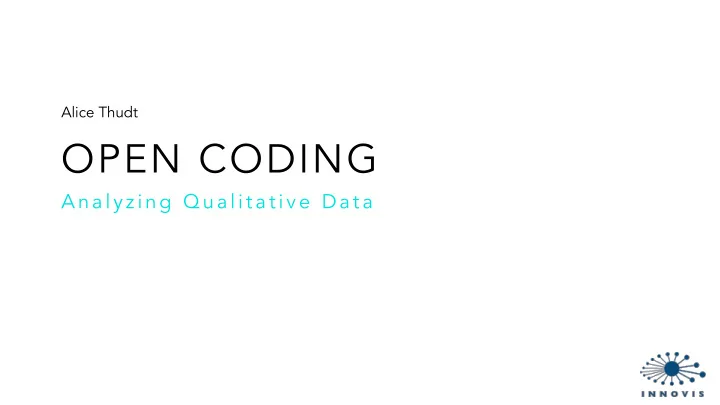

Alice Thudt OPEN CODING A n a l y z i n g Q u a l i t a t i v e D a t a
OPEN CODING part of many qualitative analysis methods, e.g. • Grounded Theory labeling concepts & developing categories from data • bottom up approach • open-ended, without pre-defined outcome •
ITERATION DATA marking, checking, coding applying CATEGORIES, CODES THEMES PATTERNS grouping, synthesizing
PROCESS Stage 1: reading: familiarize yourself with the data Specific take notes at the end (themes, unusual things) Stage 2: close reading: highlight, annotate, label note analytic ideas Stage 3: coding: systematically mark passages review codes, remove redundancies, group Abstract / Stage 4: theorizing: interpret, relate to RQs and literature General - based on Bryman’s 4 Stages of Qualitative Analysis
CLOSE READING Gibbs, G R (2011) "Examples of coding", Online QDA Web Site http://onlineqda.hud.ac.uk/Intro_QDA/coding_examples.php
Example Participant talking about her personal visualization on display in the home: “Having it in the house and visible for people to see, people would ask: `what is that you have over there?’ And my husband was following it and looking at it and I think he was interested in it. We could just talk about it without actually thinking about talking about it. It’s just something that happened because it was there. It triggered the conversations.”
CLOSE READING / LINE-BY-LINE CODING being asked visibility “Having it in the house and visible for people to see, people would ask: awareness for husband curiosity `what is that you have over there?’ And my husband was following it and enabling conversation interest by husband looking at it and I think he was interested in it. We could just talk about it serendipity without actually thinking about talking about it. It’s just something that triggering conversation presence happened because it was there. It triggered the conversations.”
LINE-BY-LINE CODING TIPS label small excerpts • stay close to the data and summarize what it is about • be specific • don’t worry about making the codes general yet • try not to lose too much richness in this step • develop ideas •
CODING CONCEPTS descriptive codes • summarize the topic of the excerpt in vivo codes • use participants’ own language analytic (or theoretical) codes • contain analytic interpretation ... •
Example Participant talking about her personal visualization on display in the home: “Having it in the house and visible for people to see, visibility evokes curiosity people would ask: `what is that you have over there?’ And my husband was following it and looking at it and following I think he was interested in it. We could just talk about serendipitous conversation it without actually thinking about talking about it. It’s just something that happened because it was there. It triggers triggered the conversations.”
CODE BIG OR SMALL DATA CHUNKS? big chunks ( -> fewer codes) + avoids de-contextualization - often vague, includes less relevant data small chunks ( -> more codes) + greater differentiation, clearer definition - loss of meaning/context, too many codes to remember
Example Participant talking about her personal visualization on display in the home: “Having it in the house and visible for people to see, people would ask: `what is that you have over there?’ And my husband was following it and looking at it and triggering conversation I think he was interested in it. We could just talk about it without actually thinking about talking about it. It’s just something that happened because it was there. It triggered the conversations.”
CODING TIPS think about precise words for your codes • use a dictionary & thesaurus • write down brief definitions • collaborate and discuss coding, if possible • helps to make codes and definitions more exact • helps to discover more nuances in the data • use memos to capture analytic ideas and questions •
MEMOS ‘(A memo is) the theorizing write-up of ideas about codes and their relationships as they strike the analyst while coding... it can be a sentence, a paragraph or a few pages... it exhausts the analyst’s momentary ideation based on data with perhaps a little conceptual elaboration’ - Glaser, 1978: 83
WHEN TO WRITE A MEMO? to record analytic ideas during coding, e.g.: • relationships between codes • commonalities or differences between pieces of data • hunches that need to be more thoroughly checked • reflective remarks • to record uncertainty, e.g. when: • struggling to clarify a concept or code • questioning a previous code or concept • identifying surprising cases in the data •
Memo Examples Hunch: “There seems to be a difference between regular conversations with the husband and sporadic interest or curiosity by visitors to the home. For the husband, the visualizations seems to enable a shared awareness of the data through conversations and being able to ‘follow’ the visualization continuously.” Question: “I wonder if the husband was already interested in the data or if seeing the visualization inspired this interest?”
DEVELOPING A CODING SCHEMA showing vis to others sharing sharing pictures of vis online sharing online sharing vis on social networks sharing in person sharing in person triggering conversations vis evokes curiosity vis triggers conversations provides opportunities for others to ask
DEVELOPING A CODING SCHEMA sharing A deliberate act of showing or discussing the visualization with others, initiated by sharing online the owner of the visualization sharing in person Instances where the visualization inspired interest that led to conversations. triggering conversations Initiated by other people seeing the visualization.
Recommend
More recommend